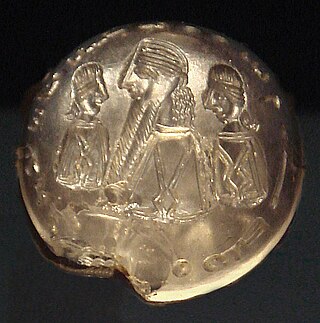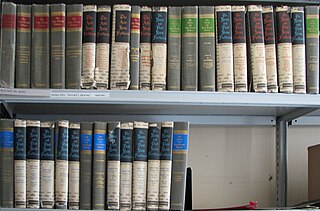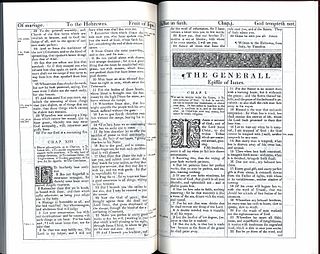Related Research Articles

Manichaeism is a former major world religion, founded in the 3rd century CE by the Parthian prophet Mani, in the Sasanian Empire.
Socrates of Constantinople, also known as Socrates Scholasticus, was a 5th-century Greek Christian church historian, a contemporary of Sozomen and Theodoret.
Jacob of Edessa was Bishop of Edessa and prominent Syriac Christian writer in Classical Syriac language, also known as one of earliest Syriac grammarians. In various works, he treated theological, liturgical, canonical, philosophical and historical subjects, and contributed significantly to scholarly and literary development of Syriac Christianity. He is considered to be one of the most important scholars of the Christian-Aramean tradition.

Patristics or patrology is the study of the early Christian writers who are designated Church Fathers. The names derive from the combined forms of Latin pater and Greek πᾰτήρ (father). The period of the Church Fathers, commonly called the Patristic era, is generally considered to run from the end of New Testament times or end of the Apostolic Age to either AD 451 or to the Second Council of Nicaea in 787.

Saint Victorinus of Pettau was an Early Christian ecclesiastical writer who flourished about 270, and who was martyred during the persecutions of Emperor Diocletian. A Bishop of Poetovio in Pannonia, Victorinus is also known as Victorinus Petavionensis or Poetovionensis. Victorinus composed commentaries on various texts within the Christians' Holy Scriptures.
Alexander of Lycopolis was an Egyptian philosopher of the late third and early fourth centuries AD. He was the writer of a short treatise, in twenty-six chapters, against the Manicheans. He says in the second chapter of this work that he derived his knowledge of Manes' teaching apo ton gnorimon.
The Apostolic Church-Ordinance is an anonymous Oriental Orthodox Christian treatise which belongs to the genre of the Church Orders. The work can be dated at the end of 3rd century CE. The provenance is usually regarded as Egypt, or perhaps Syria.
In early Christian heresiology, the Panarion, to which 16th-century Latin translations gave the name Adversus Haereses, is the most important of the works of Epiphanius of Salamis. It was written in Koine Greek beginning in 374 or 375, and issued about three years later, as a treatise on heresies, with its title referring to the text as a "stock of remedies to offset the poisons of heresy." It treats 80 religious sects, either organized groups or philosophies, from the time of Adam to the latter part of the fourth century, detailing their histories, and rebutting their beliefs. The Panarion is an important source of information on the Jewish–Christian gospels, the Gospel of the Ebionites, and the Gospel of the Hebrews.
A homiliarium or homiliary is a collection of homilies, or familiar explanations of the Gospels.
Antipater of Bostra was a Greek prelate who served as Metropolitan bishop of Bostra in the Roman province of Arabia and was one of the foremost critics of Origen. He lived in the 5th century AD.
Oecumenius is the name under which are transmitted several commentaries in Greek on the New Testament. It now appears that these were not all written by the same person nor in the same period.
Orientius was a Christian Latin poet of the fifth century.
Didascalia Apostolorum, or just Didascalia, is an early Christian legal treatise which belongs to the genre of the Church Orders. It presents itself as being written by the Twelve Apostles at the time of the Council of Jerusalem; however, scholars agree that it was actually a later composition, with most estimates suggesting the 3rd century, and other estimates suggesting potentially as late as the 4th century.
Gaius Vettius Aquilinus Juvencus was a Roman Christian poet from Hispania who wrote in Latin.
Amphilochius of Iconium was a Christian bishop of the fourth century, son of a Cappadocian family of distinction, born, perhaps at Caesara, ca. 339/340, died probably 394–403. He is venerated as a saint on November 22 in the Roman Catholic Church and on November 23 in the Orthodox Church.
Ecclesiastical history of the Catholic Church refers to the history of the Catholic Church as an institution, written from a particular perspective. There is a traditional approach to such historiography. The generally identified starting point is Eusebius of Caesarea, and his work Church History.

The Epistle to the Hebrews of the Christian Bible is one of the New Testament books whose canonicity was disputed. Traditionally, Paul the Apostle was thought to be the author. However, since the third century this has been questioned, and the consensus among most modern scholars is that the author is unknown.

Severian, Bishop of Gabala in Syria, was a popular preacher in Constantinople from around 400 until 404. He became the enemy of John Chrysostom and helped condemn him at the Synod of the Oak.
British Library, Add MS 12150 is the second oldest extant Syriac manuscript and the oldest codex bearing a date in any language.
Opus Imperfectum in Matthaeum is an early Christian commentary on the Gospel of Matthew, written sometime in the 5th century. Its name is derived from the fact that it is incomplete, omitting a number of passages from Matthew.
References
- CPG II & Supplementum Clavis Patrum Graecorum 3575 - 3578
 This article incorporates text from a publication now in the public domain : Bacchus, F.J. (1913). "Titus, Bishop of Bostra". In Herbermann, Charles (ed.). Catholic Encyclopedia . New York: Robert Appleton Company. The entry additionally cites:
This article incorporates text from a publication now in the public domain : Bacchus, F.J. (1913). "Titus, Bishop of Bostra". In Herbermann, Charles (ed.). Catholic Encyclopedia . New York: Robert Appleton Company. The entry additionally cites: - The Greek and Syriac texts of the Contra Manich., published by LAGARDE (Berlin, 1859)
- For Contra Manich. and other writings attributed to TITUS see MIGNE and GALLANDI
- SICKENBERGER in Texte u. Untersuchen, VI, i (new series)
- BARDENHEWER-SHARAN, Patrology (St. Louis, 1908), 270-1